<< Previous | Displaying results 5051-5100 of 6769 for "" | Next >>
In front of the German consulate building, writers demonstrate against Nazi book burnings. New York, United States, May 10, 1938.

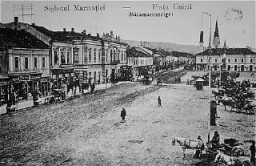
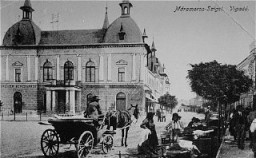
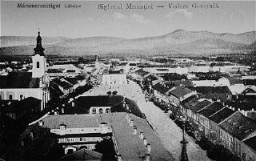
Leaders of the Sighet Jewish community. Those pictured include Mr. Hershkovich (seated far left), Mr. Klein (seated second from left), Mr. Yacobovich (standing far right), and Mr. Jahan (standing second row, right). Photograph taken ca. 1928–1930.
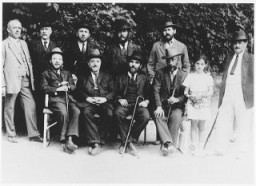
Prewar group portrait in front of a synagogue in the Transylvanian town of Sighet.
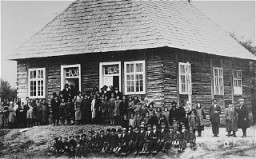
Jews bound for the rail station during deportation action from Sighet. May 18, 1944.
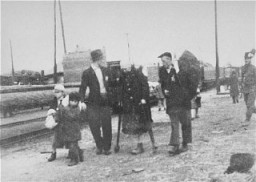
View of the burned-out Malbish Arimim synagogue on Teglash Street in Sighet. This photograph was taken after the deportation of the Jewish population. May 1944.
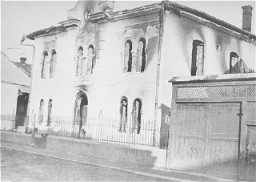
Escorted by US soldiers, child survivors of the Buchenwald concentration camp file out of the main gate of the camp. Buchenwald, Germany, April 27, 1945.
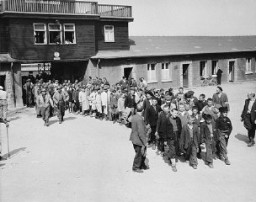
Children march out of Buchenwald to a nearby American field hospital where they will receive medical care. Buchenwald, Germany, April 27, 1945.
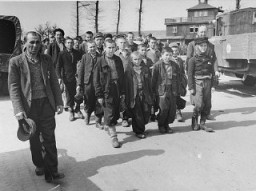
Group portrait of Jewish displaced youth at the OSE (Oeuvre de Secours aux Enfants) home for Orthodox Jewish children in Ambloy. Elie Wiesel is among those pictured. Ambloy, France, 1945.
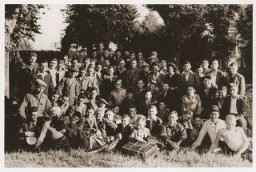
Vladka Meed shakes the hand of President Jimmy Carter at a White House Rose Garden ceremony. The ceremony marked the official presentation of the report of the US Holocaust Commission to the president by commission chairman Elie Wiesel (second from right, with Benjamin Meed, center). Washington, DC, September 27, 1979.
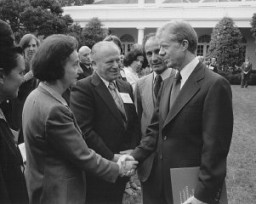
Elie Wiesel speaks at the Faith in Humankind conference, held before the opening of the United States Holocaust Memorial Museum, on September 18–19, 1984, in Washington, DC.
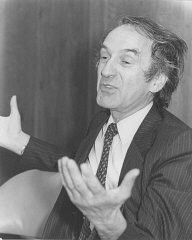
Elie Wiesel (right) with his wife and son during the Faith in Humankind conference, held several years before the opening of the United States Holocaust Memorial Museum. September 18–19, 1984, in Washington, DC.
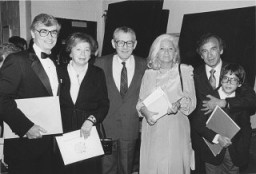
Elie Wiesel speaks at the Faith in Humankind conference, held several years before the opening of the United States Holocaust Memorial Museum. September 18–19, 1984, in Washington, DC.
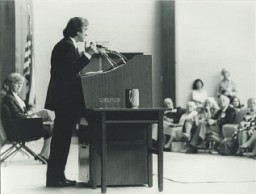
President Bill Clinton (center), Elie Wiesel (right), and Harvey Meyerhoff (left) light the eternal flame outside on the Eisenhower Plaza during the dedication ceremony of the United States Holocaust Memorial Museum. April 22, 1993.
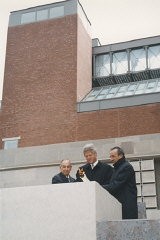
This photograph shows Auschwitz fence posts and a quote from Elie Wiesel's Night . They are on display in the third floor tower room of the Permanent Exhibition at the United States Holocaust Memorial Museum. "Never shall I forget that night, the first night in camp, which has turned my life into one long night, seven times cursed and seven times sealed. Never shall I forget that smoke. Never shall I forget the little faces of the children, whose bodies I saw turned into wreaths of smoke beneath a silent…
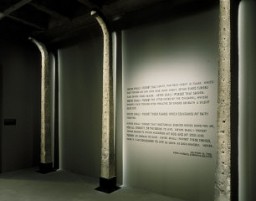
Elie Wiesel speaks at the Days of Remembrance ceremony, Washington, DC, 2001.
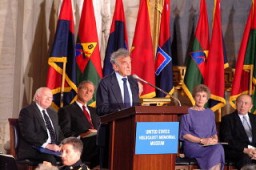
Elie Wiesel speaks at the Days of Remembrance ceremony, Washington, DC, 2002.
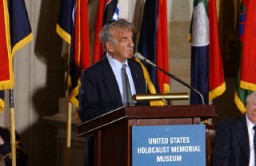
Elie Wiesel with President Ion Iliescu in Sighet following the presentation of the Final Report of the International Commission on the Holocaust in Romania.
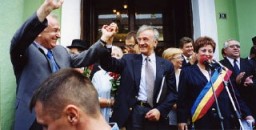
Elie Wiesel with his wife Marion and President Ion Iliescu in Sighet following the presentation of the Final Report of the International Commission on the Holocaust in Romania. Learn more about Romania facing its past.
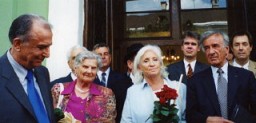
View of a camp for Soviet prisoners of war, showing the holes dug into the ground that served as shelter. The camp was located south of Hamburg in northern Germany. Wietzendorf, Germany, 1941–42.
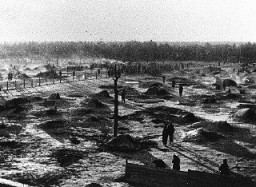
Soon after liberation, a US Army doctor examines an emaciated forced laborer, a Soviet prisoner of war. Dortmund, Germany, April 30, 1945.
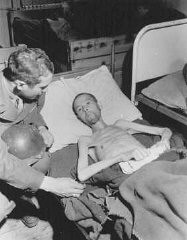
At left, a column of Soviet prisoners of war, under German guard, marches away from the front. Place uncertain, July 1, 1941.
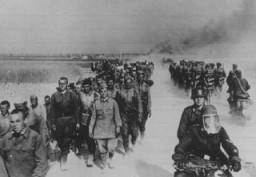
German soldiers guard Soviet prisoners of war marching to camps. Soviet Union, 1941. Second only to the Jews, Soviet prisoners of war were the largest group of victims of Nazi racial policy.
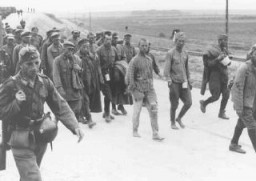
A German soldier guards Soviet prisoners of war at the Uman camp in the Ukraine. Soviet Union, August 14, 1941.
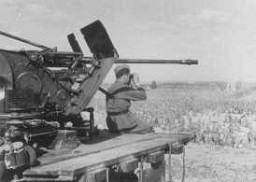
Germans guard prisoners in the Rovno camp for Soviet prisoners of war. Rovno, Poland, after June 22, 1941. Second only to the Jews, Soviet prisoners of war were the largest group of victims of Nazi racial policy.
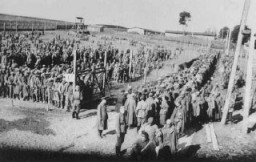
SS officers posing in front of a newly arrived transport of Soviet prisoners of war. Mauthausen concentration camp, Austria, 1941.
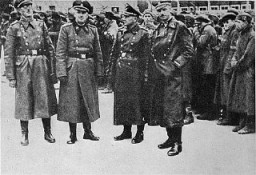
Soviet prisoners of war receiving their meager rations. More than three million Soviet prisoners of war died in German custody, mostly from malnutrition and exposure. Rovno, Poland, 1941. Second only to the Jews, Soviet prisoners of war were the largest group of victims of Nazi racial policy.
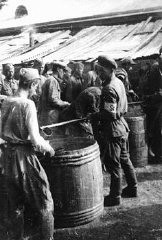
Dugouts which served as living quarters for prisoners in Stalag 319—a Nazi-built camp for Soviet prisoners of war. Chelm, Poland,1941–44.
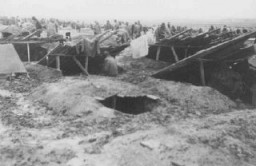
Interrogation of Soviet prisoners of war by German soldiers upon arrival at a prison camp. Lida, Poland, 1941.
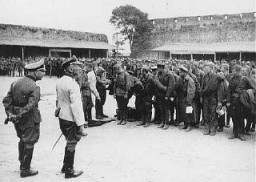
Photograph from a series taken by a guard in the Soviet prisoner-of-war camp of Belzen bei Bergen, and numbered in Roman numerals by the American officer, Lt. van Otten. The camp held approximately 10,000 POWs, most of whom came from Fallingbostel, 10 km away. When they fell ill, they were marched to Belsen. At Belsen, they were starved, often given only a soup made of field beets. This photo shows Soviet POWs assembled at the camp. Germany, 1941–45. Second only to the Jews, Soviet prisoners of war…
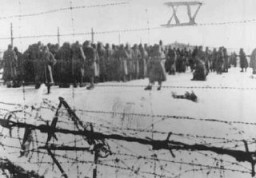
Soviet prisoners of war wait for food in Stalag (prison camp) 8C. More than 3 million Soviet soldiers died in German custody, mostly from malnutrition and exposure. Zagan, Poland, February 1942. Second only to the Jews, Soviet prisoners of war were the largest group of victims of Nazi racial policy.
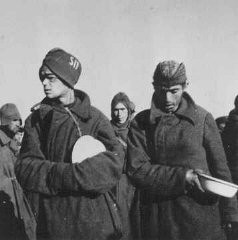
Columns of Soviet prisoners of war. Soviet Union, September 15, 1942. Second only to the Jews, Soviet prisoners of war were the largest group of victims of Nazi racial policy.
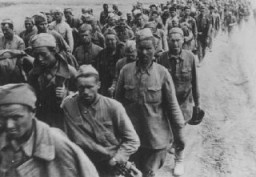
Sack of wood flour (finely powdered wood or sawdust) used to make substitute bread. The official ration of this "bread" for Soviet prisoners of war was less than 5 ounces a day. Deblin, Poland, 1942 or 1943.
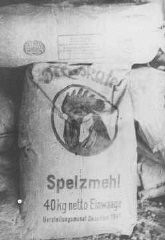
Wounded Soviet prisoners of war await medical attention. The German army provided only minimal treatment, and permitted captured Soviet personnel to care for their own wounded using only captured medical supplies. Baranovichi, Poland, wartime.
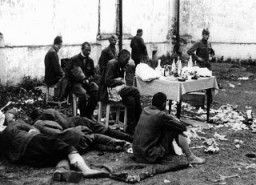
Wounded Soviet prisoners of war. The German army provided only minimal treatment, and permitted captured Soviet personnel to care for their own wounded using only captured medical supplies. Baranovichi, Poland, wartime.
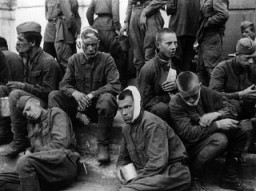
Two malnourished Soviet prisoners of war, survivors of the Hemer prisoner of war camp in western Germany. More than three million Soviet prisoners of war died in German custody, mostly from malnutrition and exposure. Hemer, Germany, April 29, 1945.
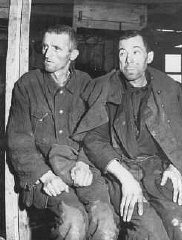
The entrance to the gas chamber in Auschwitz I, where Zyklon B was tested on Soviet prisoners of war. The building in the background is a hospital for SS members. Auschwitz, Poland, date uncertain.
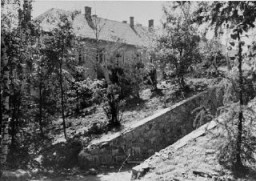
Soviet prisoners of war at forced labor build a road. Probably in the Soviet Union, about 1943.
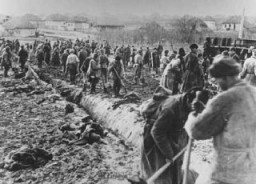
Group portrait of members of the Freemasons Lodge of Chernovtsy, Bukovina, approximately 75 percent of whom were Jewish. The members were mainly intellectuals and leaders in business and local government. Among those pictured are Dr. Max Ennis (top row, third from the left); pharmacist, Dr. Abraham Guttman (top row, far right); an official in the revenue service, Dr. Max Gottfried (second row from the top, sixth from the left); and the judge, Dr. Jacob Rubel (third row from the top, far left). Chernovtsy,…
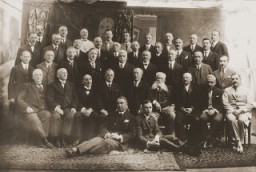
An antisemitic and anti-Masonic display at the exhibition "Der ewige Jude" (The Eternal Jew). The exhibition sought to establish a connection between Jews and Freemasons. Munich, Germany, November 10, 1937.
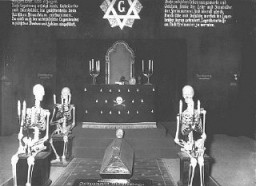
A billboard advertising an anti-Masonic exhibition organized by the anti-Masonic Belgian league, "L'Epuration," in the Masonic Supreme Council building. Brussels. Belgium, 1941. As part of their propaganda campaign against Freemasonry, the Nazis and other local right-wing organizations mounted anti-Masonic exhibitions throughout occupied Europe. German-occupied Paris hosted an anti-Masonic exhibition in October 1940, as did German-occupied Brussels in February 1941.
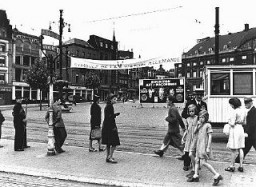
Photograph of a display entitled "British Freemasonry." It appeared in an anti-Masonic exhibition at a Berlin museum. Germany, March 7, 1941.
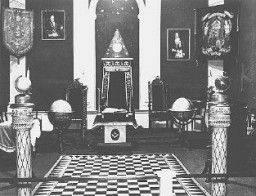
A reconstruction of a Masonic lodge from the Isle of Jersey, on display in an anti-Masonic exhibition in Nuremberg. Germany, 1938.
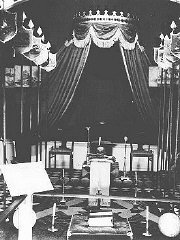
A display, entitled "British Freemasonry," at an antisemitic and anti-Masonic exhibition in Berlin. The display shows a Torah scroll and a picture of King Edward bearing Masonic regalia. Berlin, Germany, March 7, 1941.
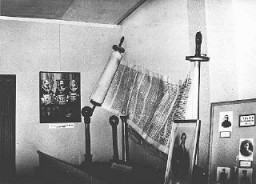
Alexander Schmorell, a member of the White Rose student opposition, upon his graduation from high school. Schmorell was arrested, condemned to death by the People's Court, and executed on July 13, 1943.
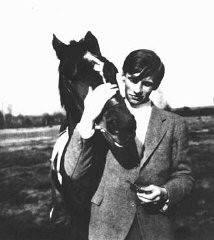
Christoph Probst, a member of the White Rose student opposition group. Probst, arrested and condemned to death by the People's Court, was executed on February 22, 1943.
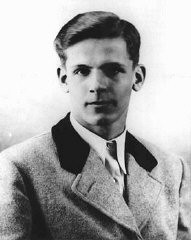
Photograph showing Blanka when she was about 1 year old, ca. 1923. She received this photograph many years later, after she came to America, from her grandmother's half brother.
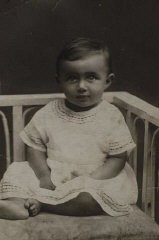
Photograph of "The Three Musketeers" —three school friends in the Lodz ghetto. Left: Lola Tenenbaum Rapoport, who survived with her husband. Center: Niusia Friedman, who was killed in Auschwitz. Lola sent this photo to Blanka Rothschild from Australia. Blanka (right) says "It's my only memento of the ghetto." With the end of World War II and collapse of the Nazi regime, survivors of the Holocaust faced the daunting task of rebuilding their lives. With little in the way of financial resources and few, if…
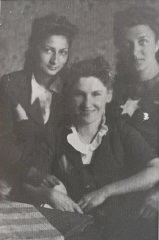
We would like to thank Crown Family Philanthropies, Abe and Ida Cooper Foundation, the Claims Conference, EVZ, and BMF for supporting the ongoing work to create content and resources for the Holocaust Encyclopedia. View the list of donor acknowledgement.